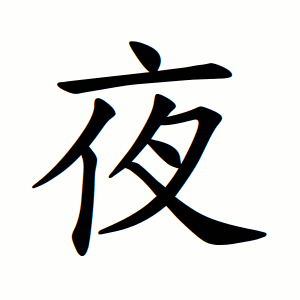夜
- night, evening, darkness;
Etymology
Phono-semantic compound composed of:
夕 (xī / 석) — “evening,” symbolizing the setting of the sun and the coming of darkness.
亦 (yì / 역) — provides the pronunciation and contributes to the idea of repetition or continuation (“again, also”).
Thus, 夜 originally expressed the continuation of evening into full darkness, the time when light is gone.
Usage in Korean
夜間 (야간) — nighttime
夜明 (야명) — dawn, daybreak (“light of night”)
夜色 (야색) — night scenery, the look of night
夜空 (야공) — night sky
夜行 (야행) — travel or move at night
夜學 (야학) — night school
夜半 (야반) — midnight
夜中 (야중) — during the night
徹夜 (철야) — all night long; overnight
夜叉 (야차) — yaksha (night demon in Buddhist context)
Words that derived from 夜
Additional notes
In Confucian and Daoist literature, 晝夜 (day and night) represents the cyclic order of yin and yang, activity and rest.
「晝以作,夜以息。」
“By day one acts, by night one rests.” — Book of Rites (禮記)
In Buddhist texts, 夜 also signifies spiritual watchfulness:
“삼경(三更)” — the “three watches of the night” — marks times for meditation.
In poetry, 夜 often conveys solitude, longing, and reflection:
「靜夜思」(정야사) — “Thoughts on a Quiet Night” (by Li Bai, 이백)
“Before my bed, moonlight shines bright; I wonder if it’s frost on the ground.”
- 卜人弓大 (YONK)
- ⿱ 亠 ⿰ 亻 ⿴ 夂 丶
